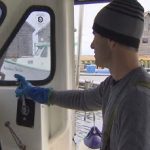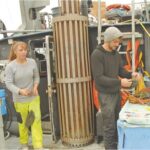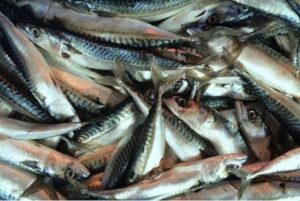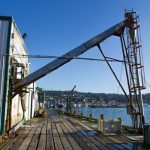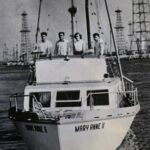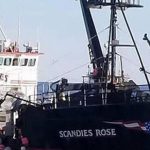Tag Archives: Oregon Department of Fish and Wildlife
Washington to negotiate on Columbia River salmon reforms
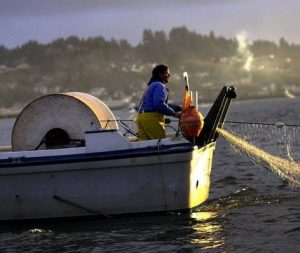 With time running short to adopt 2017 fishing seasons, the Washington Fish and Wildlife Commission on Friday delegated authority to director Jim Unsworth to negotiate the differences with Oregon regarding the controversial Columbia River salmon reforms. The Washington commission also intends to write a letter to its Oregon counterparts proposing a face-to-face meeting and to ask about Oregon’s commitment to shifting commercial fishing in the fall in the lower Columbia away from gillnets to gear allowing release of wild fish.,, In January, Washington modified its policy to allow for two more years of gillnetting between Woodland and Beacon Rock. Also in January, Oregon’s commission adopted rules much more friendly to commercial fishing. Oregon Gov. Kate Brown then scolded her commission and told it to adopt rules closer to those adopted by Washington. Read the article here 11:20
With time running short to adopt 2017 fishing seasons, the Washington Fish and Wildlife Commission on Friday delegated authority to director Jim Unsworth to negotiate the differences with Oregon regarding the controversial Columbia River salmon reforms. The Washington commission also intends to write a letter to its Oregon counterparts proposing a face-to-face meeting and to ask about Oregon’s commitment to shifting commercial fishing in the fall in the lower Columbia away from gillnets to gear allowing release of wild fish.,, In January, Washington modified its policy to allow for two more years of gillnetting between Woodland and Beacon Rock. Also in January, Oregon’s commission adopted rules much more friendly to commercial fishing. Oregon Gov. Kate Brown then scolded her commission and told it to adopt rules closer to those adopted by Washington. Read the article here 11:20
Domoic Acid raises its ugly head again…crab fishing closure
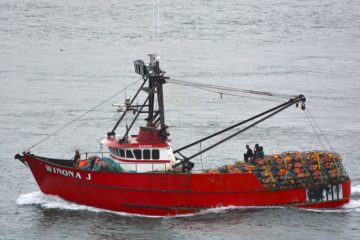 Commercial crabbing closed from Coos Bay north jetty to Heceta Head due to domoic acid The Oregon Department of Agriculture and the Oregon Department of Fish and Wildlife announce the closure of the commercial crab fishery from the north jetty of Coos Bay to Heceta Head, just south of Yachats, due to elevated levels of domoic acid in crab viscera. The area is also closed to recreational harvest. Crab meat remains safe for consumption. Domoic acid levels are elevated only in crab viscera, or the guts, of crab sampled and tested from this area of the Oregon coast. The closure is limited to that portion of the central coast. Areas south of Coos Bay and north of Heceta Head remain open to commercial crabbing. Read the story here 07:38
Commercial crabbing closed from Coos Bay north jetty to Heceta Head due to domoic acid The Oregon Department of Agriculture and the Oregon Department of Fish and Wildlife announce the closure of the commercial crab fishery from the north jetty of Coos Bay to Heceta Head, just south of Yachats, due to elevated levels of domoic acid in crab viscera. The area is also closed to recreational harvest. Crab meat remains safe for consumption. Domoic acid levels are elevated only in crab viscera, or the guts, of crab sampled and tested from this area of the Oregon coast. The closure is limited to that portion of the central coast. Areas south of Coos Bay and north of Heceta Head remain open to commercial crabbing. Read the story here 07:38
Oregon details its Columbia River fee expenditures
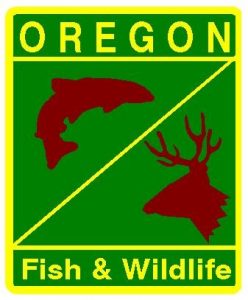 Since 2014, Oregon has spent $2.4 million it collected from a $9.75 Columbia River Endorsement tag on largely recreational fishing enhancements and research. None went to the commercial gill-net industry. At the request of The Oregonian/OregonLive, the released a dollar-specific, detailed accounting of expenditures from the endorsement fund late Friday. Agency officials hope to have the information available soon on the department’s Web site. Also detailed is $2.5 million set aside by the Oregon Legislature — $1.5 million per biennium – for assisting a transition of commercial fishing away from mainstem gill-netting. None of that money went directly to the commercial industry either. There is an additional $500,000 biennial fund for commercial netters to invest in newer, alternative fishing equipment, but department officials said no one has yet applied for any of the accumulated $1 million. Read the story here 12:04
Since 2014, Oregon has spent $2.4 million it collected from a $9.75 Columbia River Endorsement tag on largely recreational fishing enhancements and research. None went to the commercial gill-net industry. At the request of The Oregonian/OregonLive, the released a dollar-specific, detailed accounting of expenditures from the endorsement fund late Friday. Agency officials hope to have the information available soon on the department’s Web site. Also detailed is $2.5 million set aside by the Oregon Legislature — $1.5 million per biennium – for assisting a transition of commercial fishing away from mainstem gill-netting. None of that money went directly to the commercial industry either. There is an additional $500,000 biennial fund for commercial netters to invest in newer, alternative fishing equipment, but department officials said no one has yet applied for any of the accumulated $1 million. Read the story here 12:04
Shad: Following the history and biology of a East Coast transplant
 Shad were one of the largest commercial fisheries in the East during the 19th century, but overharvesting and heavy pollution prior to the environmental enlightenment of the 1970s saw the population drop faster than heavy shad dart in a slow current. Commercial harvests on the East Coast declined from nearly 20 million pounds in the 1870s to less than 2 million a hundred years later. In 1871, forward-thinking individuals at the United States Fish and Wildlife Service decided to transport shad from New York’s Hudson River to the Sacramento River in California’s Central Valley. The reasoning for this move was, in part, to add commercial and sport fisheries, as well as add another plentiful food source to the quickly swelling population of a post-Gold Rush California. Read the story here 08:41
Shad were one of the largest commercial fisheries in the East during the 19th century, but overharvesting and heavy pollution prior to the environmental enlightenment of the 1970s saw the population drop faster than heavy shad dart in a slow current. Commercial harvests on the East Coast declined from nearly 20 million pounds in the 1870s to less than 2 million a hundred years later. In 1871, forward-thinking individuals at the United States Fish and Wildlife Service decided to transport shad from New York’s Hudson River to the Sacramento River in California’s Central Valley. The reasoning for this move was, in part, to add commercial and sport fisheries, as well as add another plentiful food source to the quickly swelling population of a post-Gold Rush California. Read the story here 08:41

El Nino, Pacific Decadal Oscillation implicated in domoic acid shellfish toxicity
Using a combination of time-series data spanning two decades, the scientists not only showed a clear link between domoic acid and these larger climatic phenomena, but also developed a new model to predict with some accuracy the timing of domoic acid risks in the Pacific Northwest. The model is based on interpreting the status of the “Oceanic Niño Index” and the Pacific Decadal Oscillation – both of which are measures of climate, ocean water movement, currents and temperature. It’s designed to help coastal resource managers more effectively monitor this issue and protect public health. The findings were made by researchers from Oregon State University, the University of Oregon, the National Oceanic and Atmospheric Association (NOAA), and the Oregon Department of Fish and Wildlife. The work was primarily supported by NOAA. Read the article here 08:01
Crab price spat delays season – Fishermen in District 7 not fishing until the buyer offers the original $3
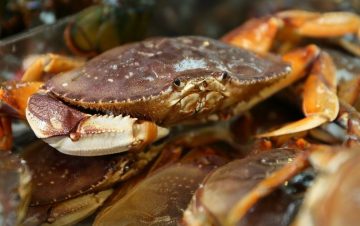 Negotiations with Pacific Group failed to secure an acceptable price range for local crab fisherman in District 7, stretching from Humboldt Bay’s North Jetty to Point Arena in Mendocino. Crab prices have been set $3 a pound since the November opening of the season. Pacific Group, which owns Pacific Choice Seafood in Humboldt County, has proposed crab prices be reduced to $2.75 per pound. According to Ken Bates, vice president of the Humboldt Fishermen’s Marketing Association, if fisherman decided to fish for less, local boats would lose between $7,000 to $10,000 for the average medium to small boat. “Fisherman representatives have been meeting all (Tuesday) afternoon in Newport, Oregon, and as of 4 p.m. there have not been any resolutions. We may continue (Wednesday) and there’s a possibility that the Oregon Department of Fish and Wildlife will set a mediation, which is a compromised price on the crab,” Bates said. “The buyer wanted to drop the price and attempted to lower it by 25 cents.” Read the story here 13:53
Negotiations with Pacific Group failed to secure an acceptable price range for local crab fisherman in District 7, stretching from Humboldt Bay’s North Jetty to Point Arena in Mendocino. Crab prices have been set $3 a pound since the November opening of the season. Pacific Group, which owns Pacific Choice Seafood in Humboldt County, has proposed crab prices be reduced to $2.75 per pound. According to Ken Bates, vice president of the Humboldt Fishermen’s Marketing Association, if fisherman decided to fish for less, local boats would lose between $7,000 to $10,000 for the average medium to small boat. “Fisherman representatives have been meeting all (Tuesday) afternoon in Newport, Oregon, and as of 4 p.m. there have not been any resolutions. We may continue (Wednesday) and there’s a possibility that the Oregon Department of Fish and Wildlife will set a mediation, which is a compromised price on the crab,” Bates said. “The buyer wanted to drop the price and attempted to lower it by 25 cents.” Read the story here 13:53
State of Oregon opens portion of coast for commercial Dungeness crabbing
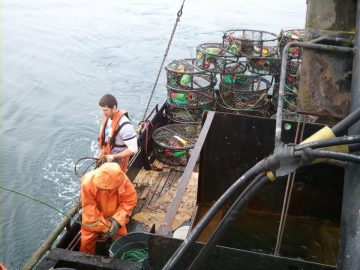 The Oregon Department of Fish and Wildlife and the Oregon Department of Agriculture have announced that the opening of the commercial crab season from Cape Blanco to the Oregon/California border is set for Dec. 18.“We have consistently taken a very precautionary approach when opening our crab fisheries,” said ODFW Marine Resources Program Manager Caren Braby. “Recent test results have consistently shown low biotoxin results on the southern end of the state and decreasing levels in ports north of this area indicating they are of excellent quality, safe for consumption and ready for harvest.” In addition, the Oregon Dungeness Crab Commission announced Tuesday that Oregon Dungeness crab fishermen and seafood processor representatives participating in state-supervised crab price negotiations have agreed on an opening price of $3 per pound for the 2017 Dungeness crab season partial opening this week. Read the rest of the story here 08:59
The Oregon Department of Fish and Wildlife and the Oregon Department of Agriculture have announced that the opening of the commercial crab season from Cape Blanco to the Oregon/California border is set for Dec. 18.“We have consistently taken a very precautionary approach when opening our crab fisheries,” said ODFW Marine Resources Program Manager Caren Braby. “Recent test results have consistently shown low biotoxin results on the southern end of the state and decreasing levels in ports north of this area indicating they are of excellent quality, safe for consumption and ready for harvest.” In addition, the Oregon Dungeness Crab Commission announced Tuesday that Oregon Dungeness crab fishermen and seafood processor representatives participating in state-supervised crab price negotiations have agreed on an opening price of $3 per pound for the 2017 Dungeness crab season partial opening this week. Read the rest of the story here 08:59
ODFW and ODA close crabbing along large part of Oregon coast
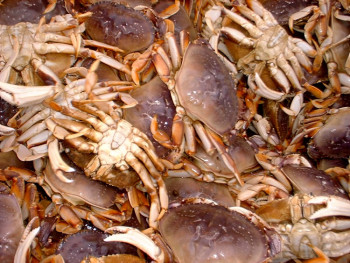 The Oregon Department of Agriculture and ODFW announced Friday recreational and commercial bay crabbing from Tillamook Head to the California border is closed due to elevated levels of domoic acid. Officials say they found elevated domoic acid levels in the viscera of Dungeness crab collected between Cascade Head and Cape Falcon. This triggered a biotoxin closure. The closure includes harvesting Dungeness and red rock crab in bays and estuaries, off docks, piers, jetties, and the ocean. The coastal areas outside of where the domoic acid was found are closed out of precaution while officials process more samples. The additional sample results could allow ODFW and the Department of Agriculture to reopen some areas and open the ocean crab fisheries, which are scheduled to open December 1. Read the rest here 17:36
The Oregon Department of Agriculture and ODFW announced Friday recreational and commercial bay crabbing from Tillamook Head to the California border is closed due to elevated levels of domoic acid. Officials say they found elevated domoic acid levels in the viscera of Dungeness crab collected between Cascade Head and Cape Falcon. This triggered a biotoxin closure. The closure includes harvesting Dungeness and red rock crab in bays and estuaries, off docks, piers, jetties, and the ocean. The coastal areas outside of where the domoic acid was found are closed out of precaution while officials process more samples. The additional sample results could allow ODFW and the Department of Agriculture to reopen some areas and open the ocean crab fisheries, which are scheduled to open December 1. Read the rest here 17:36
Astoria gillnetters, recreational anglers renew battle – Kitzhaber salmon plan getting tough review
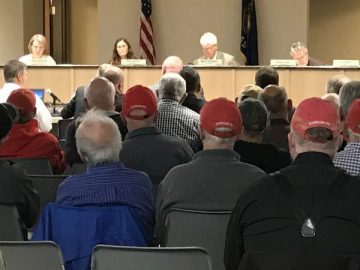 More than 100 people filled Oregon Department of Fish and Wildlife’s meeting room Wednesday as the state wildlife commission heard testimony on the status of Columbia River salmon and steelhead runs and how they are harvested by commercial and sport anglers. The commission won’t take additional action on the recommendations until December, but the argument is hot and divisive. Recreational anglers, including fishing guides and led by the Coastal Conservation Association, are furious at the proposal and consider it a betrayal of the four-year transition plan agreed to by Oregon and Washington state. Dozens of them piled into the meeting room, many wearing red CCA hats and sporting stickers proclaiming “No broken promises.” In a letter to commission members, CCA Oregon Chairman Dave Schamp said it would be irresponsible to allow the gillnet fleet’s continued use of “archaic and destructive gear.” He and others believe beach and purse seines are a viable alternative to gillnets. Commercial fishers strongly disagree. Read the story here, and read Kitzhaber salmon plan getting tough review – Read the story here 15:20
More than 100 people filled Oregon Department of Fish and Wildlife’s meeting room Wednesday as the state wildlife commission heard testimony on the status of Columbia River salmon and steelhead runs and how they are harvested by commercial and sport anglers. The commission won’t take additional action on the recommendations until December, but the argument is hot and divisive. Recreational anglers, including fishing guides and led by the Coastal Conservation Association, are furious at the proposal and consider it a betrayal of the four-year transition plan agreed to by Oregon and Washington state. Dozens of them piled into the meeting room, many wearing red CCA hats and sporting stickers proclaiming “No broken promises.” In a letter to commission members, CCA Oregon Chairman Dave Schamp said it would be irresponsible to allow the gillnet fleet’s continued use of “archaic and destructive gear.” He and others believe beach and purse seines are a viable alternative to gillnets. Commercial fishers strongly disagree. Read the story here, and read Kitzhaber salmon plan getting tough review – Read the story here 15:20

Oregon proposes ‘rebalance’ of Columbia River salmon reforms
The Oregon Department of Fish and Wildlife is proposing a “strategic rebalance” of the landmark 2012 Columbia River salmon management reforms, including continuation of gillnetting for fall chinook between Woodland and Beacon Rock. The department’s recommendations will be presented to the Oregon Fish and Wildlife Commission in a one-topic, all-day meeting beginning at 8 a.m. Wednesday at the Department of Fish and Wildlife headquarters, 4034 Fairview Industrial Drive, Salem. In late 2012 and early 2013, the Washington and Oregon commissions adopted the biggest overhaul of Columbia River salmon policies in seven decades. Jump-started by former Oregon Gov. John Kitzhaber, the policies called for allocating more chinook salmon to sportsmen in the main Columbia and restricting gillnetting to off-channel sites like Youngs Bay near Astoria. Among recommendations for 2017 developed by the Oregon Department of Fish and Wildlife are: Read the rest here 11:17
Illuminating Fishing Nets Prevent Bycatch
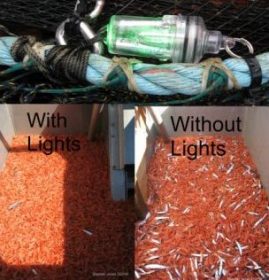 Bycatch is an economic and environmental problem for commercial fishing. Large trawlers often scoop up sea-life other than the species they’re targeting, and if there’s too much bycatch fishermen sometimes have to dump their catch. But Bob Hannah of the Oregon Department of Fish and Wildlife may have found a simple, affordable solution. He tells Living on Earth’s Emmett FitzGerald how local shrimp fishermen are eliminating bycatch of an important smelt species by lighting up their nets with LEDs. The waters off the coast of Oregon teem with delectable pink shrimp. But shrimpers often also scoop up fish they don’t want, what’s known as “by-catch”, in particular a smelt called the eulachon. And that is costly – for the eulachon, and the fishing boat operators. But Government scientists have discovered a nifty way to cut the eulachon by-catch using LED lights. Bob Hannah of the Oregon Department of Fish and Wildlife told Living on Earth’s Emmett FitzGerald all about it. Read the story here 19:59
Bycatch is an economic and environmental problem for commercial fishing. Large trawlers often scoop up sea-life other than the species they’re targeting, and if there’s too much bycatch fishermen sometimes have to dump their catch. But Bob Hannah of the Oregon Department of Fish and Wildlife may have found a simple, affordable solution. He tells Living on Earth’s Emmett FitzGerald how local shrimp fishermen are eliminating bycatch of an important smelt species by lighting up their nets with LEDs. The waters off the coast of Oregon teem with delectable pink shrimp. But shrimpers often also scoop up fish they don’t want, what’s known as “by-catch”, in particular a smelt called the eulachon. And that is costly – for the eulachon, and the fishing boat operators. But Government scientists have discovered a nifty way to cut the eulachon by-catch using LED lights. Bob Hannah of the Oregon Department of Fish and Wildlife told Living on Earth’s Emmett FitzGerald all about it. Read the story here 19:59
The Oregon Department of Fish and Wildlife has drafted a “forage fish” plan
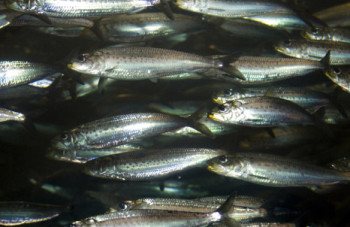 Oregon fishery managers are quietly embarking on a plan to ban new commercial fisheries on several species of small ocean fish considered diet staples for salmon and sea birds. The Oregon Department of Fish and Wildlife has drafted a plan to ensure that certain smelts, squids, sand lance and other so-called “forage fish” remain prey for larger fish like salmon and myriad sea birds in Oregon’s near-shore waters. The draft plan does not restrict any current commercial fisheries. But it does address “by-catch” that occurs during commercial seasons for species such as sardine and Pacific whiting in which non-target species are caught. Only Alaska has a similar ban on new commercial seasons on near-shore forage fish, according to the Pew Charitable Trust, which has trumpeted forage-fish protection for years. Read the story here Read Dick Grachek’s, THE FORAGE FISH FARCE Click here 12:50
Oregon fishery managers are quietly embarking on a plan to ban new commercial fisheries on several species of small ocean fish considered diet staples for salmon and sea birds. The Oregon Department of Fish and Wildlife has drafted a plan to ensure that certain smelts, squids, sand lance and other so-called “forage fish” remain prey for larger fish like salmon and myriad sea birds in Oregon’s near-shore waters. The draft plan does not restrict any current commercial fisheries. But it does address “by-catch” that occurs during commercial seasons for species such as sardine and Pacific whiting in which non-target species are caught. Only Alaska has a similar ban on new commercial seasons on near-shore forage fish, according to the Pew Charitable Trust, which has trumpeted forage-fish protection for years. Read the story here Read Dick Grachek’s, THE FORAGE FISH FARCE Click here 12:50
Despite delay, Dungeness maintain strong economic grip
 While some commercial crab fishermen are still trickling into ports in Oregon and Washington, the majority of commercial crabbing has slowed for the season as attention turns toward other fisheries. Those remaining are primarily doing so for the live crab market, which fetches top dollar. Oregon and Washington landings, The latest total for Oregon is 13.8 million pounds, according to the Oregon Department of Fish and Wildlife (ODFW) — a dramatic increase from the 8.2 million caught in 2014-15. The Port of Astoria has recorded 4.4 million pounds. Oregon landed 9.7 million pounds in January alone. In February 2.7 million pounds were recorded. The catch slowed to 700,000 in March and 440,0000 in April, respectively. Washington’s January catch also eclipsed the total for the 2014-15 season. Read the rest here 08:59
While some commercial crab fishermen are still trickling into ports in Oregon and Washington, the majority of commercial crabbing has slowed for the season as attention turns toward other fisheries. Those remaining are primarily doing so for the live crab market, which fetches top dollar. Oregon and Washington landings, The latest total for Oregon is 13.8 million pounds, according to the Oregon Department of Fish and Wildlife (ODFW) — a dramatic increase from the 8.2 million caught in 2014-15. The Port of Astoria has recorded 4.4 million pounds. Oregon landed 9.7 million pounds in January alone. In February 2.7 million pounds were recorded. The catch slowed to 700,000 in March and 440,0000 in April, respectively. Washington’s January catch also eclipsed the total for the 2014-15 season. Read the rest here 08:59
Commercials to net Columbia River on Tuesday. Why would they bother?
 Ten hours of commercial fishing — but with a four spring chinook-per-vessel limit — are scheduled Tuesday in the lower Columbia River. Washington and Oregon officials adopted the fishery on Monday. Netting with 4.25-inch-minimum mesh nets will be allowed from 10 a.m. to 8 p.m. from Beacon Rock to the ocean. The commercial fleet has an early-season allocation of 1,222 upper Columbia-origin spring chinook plus 7,150 Willamette River-origin chinook, said biologist John North of the Oregon Department of Fish and Wildlife. Last Tuesday, the commercials fished nine hours and landed 1,192 total spring chinook and 890 upper Columbia-origin chinook from 86 deliveries. Read the article, click here 20:28
Ten hours of commercial fishing — but with a four spring chinook-per-vessel limit — are scheduled Tuesday in the lower Columbia River. Washington and Oregon officials adopted the fishery on Monday. Netting with 4.25-inch-minimum mesh nets will be allowed from 10 a.m. to 8 p.m. from Beacon Rock to the ocean. The commercial fleet has an early-season allocation of 1,222 upper Columbia-origin spring chinook plus 7,150 Willamette River-origin chinook, said biologist John North of the Oregon Department of Fish and Wildlife. Last Tuesday, the commercials fished nine hours and landed 1,192 total spring chinook and 890 upper Columbia-origin chinook from 86 deliveries. Read the article, click here 20:28
Oregon: Commercial Dungeness crab season opens Jan. 4
 Testing of crab in recent weeks show the elevated levels of domoic acid in the southern half of the state have decreased and are all below U.S. Food and Drug Administration alert levels for three sample periods in a row. Based on these results and consultations with the Oregon Department of Agriculture, the Oregon commercial crab industry and Washington and California Departments of Fish and Wildlife, the Oregon Department of Fish and Wildlife is opening the ocean commercial Dungeness crab season along the entire Oregon coast just after the New Year, Jan 4. Read the press release here 20:57
Testing of crab in recent weeks show the elevated levels of domoic acid in the southern half of the state have decreased and are all below U.S. Food and Drug Administration alert levels for three sample periods in a row. Based on these results and consultations with the Oregon Department of Agriculture, the Oregon commercial crab industry and Washington and California Departments of Fish and Wildlife, the Oregon Department of Fish and Wildlife is opening the ocean commercial Dungeness crab season along the entire Oregon coast just after the New Year, Jan 4. Read the press release here 20:57
Oregon hunting, angling and commercial fishing fees will go up dramatically to feed a ravenous bureaucracy

Washington and Oregon officials today cancelled gillnetting scheduled for tonight in the lower Columbia River.
 Biologist Jeff Whisler of the Oregon Department of Fish and Wildlife said the commercial fleet has caught 3,298 summer chinook salmon in two earlier nights of fishing. That number is 99 percent of the commercial allocation. Whisler said the commercials are projected to catch another 700 chinook if they fished tonight. The Columbia River Technical Advisory Committee has upgraded the forecast for the summer chinook run to 108,000, the largest since at least 1960. The sockeye run was upgraded Monday to 500,000, the third largest on record. link 14:34
Biologist Jeff Whisler of the Oregon Department of Fish and Wildlife said the commercial fleet has caught 3,298 summer chinook salmon in two earlier nights of fishing. That number is 99 percent of the commercial allocation. Whisler said the commercials are projected to catch another 700 chinook if they fished tonight. The Columbia River Technical Advisory Committee has upgraded the forecast for the summer chinook run to 108,000, the largest since at least 1960. The sockeye run was upgraded Monday to 500,000, the third largest on record. link 14:34
Warm water expected to keep killing Willamette River salmon
 Higher water temperatures in the Willamette River are most likely the cause of spring Chinook salmon deaths, according to fish biologists from the Oregon Department of Fish and Wildlife.According to ODFW, this year Chinook are dying earlier than usual. Most spring Chinook salmon usually die in the fall after they have spawned. The good news: More than 51,000 fish have crossed at Willamette Falls, well above the 50-year average of 41,000 fish. Read the rest here 14:46
Higher water temperatures in the Willamette River are most likely the cause of spring Chinook salmon deaths, according to fish biologists from the Oregon Department of Fish and Wildlife.According to ODFW, this year Chinook are dying earlier than usual. Most spring Chinook salmon usually die in the fall after they have spawned. The good news: More than 51,000 fish have crossed at Willamette Falls, well above the 50-year average of 41,000 fish. Read the rest here 14:46
Light up the nets! Easy Solution for Shrimpers and Smelt Alike
 Along with pink shrimp, their nets often scoop up a threatened smelt called eulachon. Many shrimpers worry that the species’ vulnerability could lead to new federal restrictions on their industry. Now scientists in Oregon seem to have hit upon an effective and low-cost solution: Light up the nets. Last July, fisheries biologists Robert Hannah and Stephen Jones of the Oregon Department of Fish and Wildlife and Mark Lomeli of the Pacific States Marine Fisheries Commission chartered a shrimp trawler for an unusual experiment. Read the rest here 20:56
Along with pink shrimp, their nets often scoop up a threatened smelt called eulachon. Many shrimpers worry that the species’ vulnerability could lead to new federal restrictions on their industry. Now scientists in Oregon seem to have hit upon an effective and low-cost solution: Light up the nets. Last July, fisheries biologists Robert Hannah and Stephen Jones of the Oregon Department of Fish and Wildlife and Mark Lomeli of the Pacific States Marine Fisheries Commission chartered a shrimp trawler for an unusual experiment. Read the rest here 20:56
Court of Appeals rejects gillnet lawsuit – may go to Oregon Supreme Court.
 A lawsuit challenging changes to the lower Columbia River gillnet policy was rejected Wednesday morning by the Oregon Court of Appeals. Steve Fick, owner of Fishhawk Fisheries, and Salmon for All President Jim Wells sued the Oregon Department of Fish and Wildlife over the process of rule-making regarding a proposed gillnet policy. The policy, created by former Gov. John Kitzhaber in August 2012, orders that gillnetting be phased out on the Columbia River’s main stem. Read the rest here 10:54
A lawsuit challenging changes to the lower Columbia River gillnet policy was rejected Wednesday morning by the Oregon Court of Appeals. Steve Fick, owner of Fishhawk Fisheries, and Salmon for All President Jim Wells sued the Oregon Department of Fish and Wildlife over the process of rule-making regarding a proposed gillnet policy. The policy, created by former Gov. John Kitzhaber in August 2012, orders that gillnetting be phased out on the Columbia River’s main stem. Read the rest here 10:54
The Oregon Dungeness commercial crab fishing season started on time this year
 “It’s been delayed the last two years, but this year we’ve got a Dec. 1 opener,” Hugh Link said last week. Link, the executive director of the Oregon Dungeness Crab Commission, said the opening is set by the Oregon Department of Fish and Wildlife and is based, up and down the coast, on the percentage of fill rate of the crab. Full story here 17:35
“It’s been delayed the last two years, but this year we’ve got a Dec. 1 opener,” Hugh Link said last week. Link, the executive director of the Oregon Dungeness Crab Commission, said the opening is set by the Oregon Department of Fish and Wildlife and is based, up and down the coast, on the percentage of fill rate of the crab. Full story here 17:35
ODFW to host public meetings on commercial nearshore fishery
 NEWPORT — The Oregon Department of Fish and Wildlife will discuss the commercial black and blue rockfish and nearshore fisheries at three public meetings in Brookings, Port Orford and Pacific City in late September and early October. Read the rest here 17:53
NEWPORT — The Oregon Department of Fish and Wildlife will discuss the commercial black and blue rockfish and nearshore fisheries at three public meetings in Brookings, Port Orford and Pacific City in late September and early October. Read the rest here 17:53
ODFW seeks new members for Fishery Permit Review Board
 The permit review board evaluates limited entry permit denials made by ODFW and considers requests for permit transfers for the following commercial fisheries: sea urchin, roe herring, Columbia River gillnet salmon, ocean troll salmon, ocean shrimp/scallop, ocean crab, sardine, bay clam dive, brine shrimp, blue and black rockfish and nearshore fisheries. Read more here 16:17
The permit review board evaluates limited entry permit denials made by ODFW and considers requests for permit transfers for the following commercial fisheries: sea urchin, roe herring, Columbia River gillnet salmon, ocean troll salmon, ocean shrimp/scallop, ocean crab, sardine, bay clam dive, brine shrimp, blue and black rockfish and nearshore fisheries. Read more here 16:17
Oregon trawlers re-up their shrimp certification
 The Oregon Trawl Commission learned this week the Oregon pink shrimp it catches will again received certification from the Marine Stewardship Council. The group was the first to receive the Commission’s certification in 2007. Ten other fisheries have since earned the honor. Read more MSC propaganda here 19:59
The Oregon Trawl Commission learned this week the Oregon pink shrimp it catches will again received certification from the Marine Stewardship Council. The group was the first to receive the Commission’s certification in 2007. Ten other fisheries have since earned the honor. Read more MSC propaganda here 19:59
Effective Management? – ODFW plans hazing of fish-eating double-crested cormorants, a protected species??
 Hazing of double-crested cormorants is set to begin soon in several areas along the Oregon coast in an attempt to improve survival of juvenile salmon and steelhead as they migrate from inland waters to the Pacific, the Oregon Department of Fish and Wildlife said Monday. Read more here ktzv.com 15:09
Hazing of double-crested cormorants is set to begin soon in several areas along the Oregon coast in an attempt to improve survival of juvenile salmon and steelhead as they migrate from inland waters to the Pacific, the Oregon Department of Fish and Wildlife said Monday. Read more here ktzv.com 15:09
Judge orders Oregon hatchery to release fewer fish
 PORTLAND, Ore. (AP) – A judge has ordered federal fish managers in Oregon to release fewer young salmon into the Sandy River this year to ensure that hatchery fish don’t harm wild fish – but has left other hatchery operations intact. Read more here 12:23
PORTLAND, Ore. (AP) – A judge has ordered federal fish managers in Oregon to release fewer young salmon into the Sandy River this year to ensure that hatchery fish don’t harm wild fish – but has left other hatchery operations intact. Read more here 12:23
Scientists present evidence of correlation between migration patterns of salmon and magnetic field
 A team of scientists last year presented evidence of a correlation between the migration patterns of ocean salmon and the Earth’s magnetic field, suggesting it may help explain how the fish can navigate across thousands of miles of water to find their river of origin. Read [email protected] 10:56
A team of scientists last year presented evidence of a correlation between the migration patterns of ocean salmon and the Earth’s magnetic field, suggesting it may help explain how the fish can navigate across thousands of miles of water to find their river of origin. Read [email protected] 10:56
In depth: Fins Up for Oregon’s Albacore Tuna Season – Trollers land second highest to-the-boat value in past decade
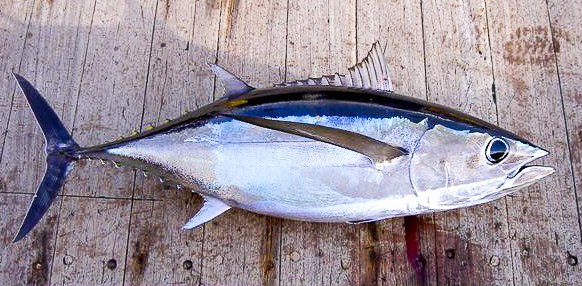 It was almost the worst of times. It was almost the best of times. After another lackluster opening that spawned worries among commercial fishermen, the Oregon albacore tuna fishery went on a wild late season run to bring in 10,104,702 pounds of tuna that fetched to-the-boat revenue of $15,916,410. Those numbers easily bested the 10-year averages of 9.8 million pounds and $11.9 million. Read more@fishermensnews 17:42
It was almost the worst of times. It was almost the best of times. After another lackluster opening that spawned worries among commercial fishermen, the Oregon albacore tuna fishery went on a wild late season run to bring in 10,104,702 pounds of tuna that fetched to-the-boat revenue of $15,916,410. Those numbers easily bested the 10-year averages of 9.8 million pounds and $11.9 million. Read more@fishermensnews 17:42
Oregon Department of Fish and Wildlife seeks candidates for Commercial Fishery Permit Board
 The Permit Board is composed of three individuals representing commercial fishers from each fishery plus two at-large public members. Currently, there are 11 vacant positions to represent the following fisheries: sea urchin, roe herring, Columbia River gillnet salmon, ocean shrimp/scallop, brine shrimp, blue and black rockfish, and nearshore fisheries. Read more@worldlink 16:15
The Permit Board is composed of three individuals representing commercial fishers from each fishery plus two at-large public members. Currently, there are 11 vacant positions to represent the following fisheries: sea urchin, roe herring, Columbia River gillnet salmon, ocean shrimp/scallop, brine shrimp, blue and black rockfish, and nearshore fisheries. Read more@worldlink 16:15






 “First of all, we don’t have the population pressures on our coast that Washington and California do,” he said. “So, we have room for commercial fisheries — fleets, processing centers — those are the kind of things that have been the backbone of the Oregon coast for many decades. But, that’s really true now, thanks to the increased demand for the quality seafood that we produce off our coast.”
“First of all, we don’t have the population pressures on our coast that Washington and California do,” he said. “So, we have room for commercial fisheries — fleets, processing centers — those are the kind of things that have been the backbone of the Oregon coast for many decades. But, that’s really true now, thanks to the increased demand for the quality seafood that we produce off our coast.” 


























